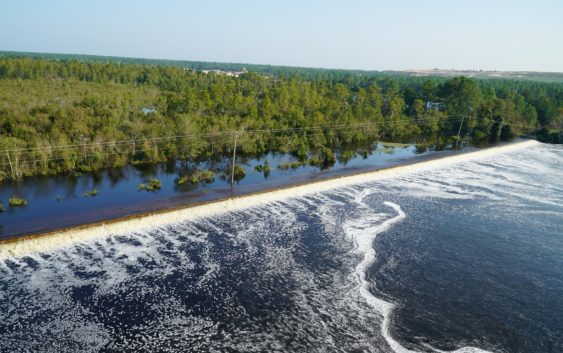- Big March storm system threatens US with tornadoes, blizzards and wildfire risk
- As city leaders consider expanding at-risk zone for wildfire damage, home builders say it could raise costs
- Is your neighborhood at high wildfire risk? | Here's how to check the city's wildfire risk map
- 'Be prepared now': Brad Panovich updates severe weather risk for Sunday
- 'Be prepared now': Brad Panovich updates severe weather risk for Sunday
HURRICANE FLORENCE: Dam breached; coal ash leaks feared

Floodwaters force Duke power plant at Sutton Lake to shut down; coal ash could escape into the Cape Fear River
NEW HANOVER COUNTY — Environmental groups and regulators scrambled Friday after the earthen dam at Sutton Lake breached in several areas, with water from the Cape Fear River also tipping into an on-site basin used to store coal ash.
“In real basic terms, it means that the river and the lake and the 1971 coal ash pond are all the same thing right now so it’s unquestionably releasing coal ash into the river above the City of Wilmington,” Kemp Burdette, the Cape Fear Riverkeeper, said Friday afternoon as he prepared to launch boats into the river to take samples near the site.
Duke, for its part, insists that while lightweight beads associated with coal ash are being found in Sutton Lake, coal ash has remained in the 1971 ash basin next to Sutton Lake. Friday’s breach also resulted in flooding at Duke’s 625-megawatt natural gas plant on the site off U.S. 421, leading to the power giant shutting that plant down.
Floodwaters began leaving Sutton Lake at several breaches on the 1,100-acre lake’s southern end, Duke said in a release, with one large breach and several smaller one.
“It’s a very dangerous situation, and we don’t yet know the full extent of the risk,” said Frank Holleman, a senior attorney from the Southern Environmental Law Center (SELC).
There are two coal ash basins on the site, one from 1971 and another from 1984. According to the Associated Press, Duke Energy spokeswoman Paige Sheehan said floodwaters had overtopped a steel retaining wall at the 1971 basin, and the company could not rule out that ash might be escaping into the river.
A July 2018 inspection found that 900,000 cubic yards of coal ash were in the 1971 basin, along with 430,000 cubic yards of impounded water.
Holleman said Friday’s events, specifically regarding coal ash, were avoidable and that Duke should resolve in the coming days to move all coal ash from basins like those next to Sutton Lake.
“This is a crisis that nobody in the Wilmington community should have to be worrying about on top of all the other problems Wilmington has from this flood, but it’s a problem Duke Energy has inflicted on North Carolina and the Wilmington community,” Holleman said.
In its Friday announcement, Duke said water remains more than 10 feet from the 1984 ash basin’s dike, which to this point has been stable.
The N.C. Department of Environmental Quality (DEQ) continues to monitor the situation and is sending a staff member to take aerial photos of the Sutton site Friday afternoon. Regulators are also in the area in chest waders trying to monitor the situation.
Thursday Duke announced that the flooding had prompted the company to move to a level-one emergency, up from level two Wednesday night and level three Wednesday afternoon.
Aerial photos from Thursday morning showed erosion on the cement and soil interior of the berm, the company said in a release.
Should the dam breach, Duke spokeswoman Erin Culbert said on Thursday, the company believes there would not be a noticeable change in water levels on the Cape Fear River. Culbert also said Duke believes a breach would not lead to a wave of water into the Cape River because the flooding is inundating the lake.
“Because of the really flooded conditions around the plant site,” Culbert said, “you are not likely to see a measurable change if you do experience a breach, so that’s a positive.”
The earthen berm was built in 1972 to create Sutton Lake, a reservoir that supplies cooling water to the Sutton power plant. Sutton Lake is not used to store coal ash, which is held in a pair of nearby basins and at an under-construction landfill on plant property.
According to the National Weather Service, the Cape Fear River in Wilmington is supposed to peak Saturday around 8 p.m. Duke recorded more than 33 inches of rainfall from Hurricane Florence.
Thursday’s emergency action plan notice was required, Culbert said, after water from the Cape Fear River began to leak into the cooling lake. In addition to notifying state regulators and local emergency management officials, Duke has opened a pair of 24-inch valves to lower water levels in the lake and pre-positioned construction materials on the site.
“All of those things happened the way they should,” Culbert said Thursday, “and that simply lets us respond quickly if we need to.”
Less than a day later, Duke needed to.
Contact the Metro desk at Breakingnews@StarNewsOnline.com.